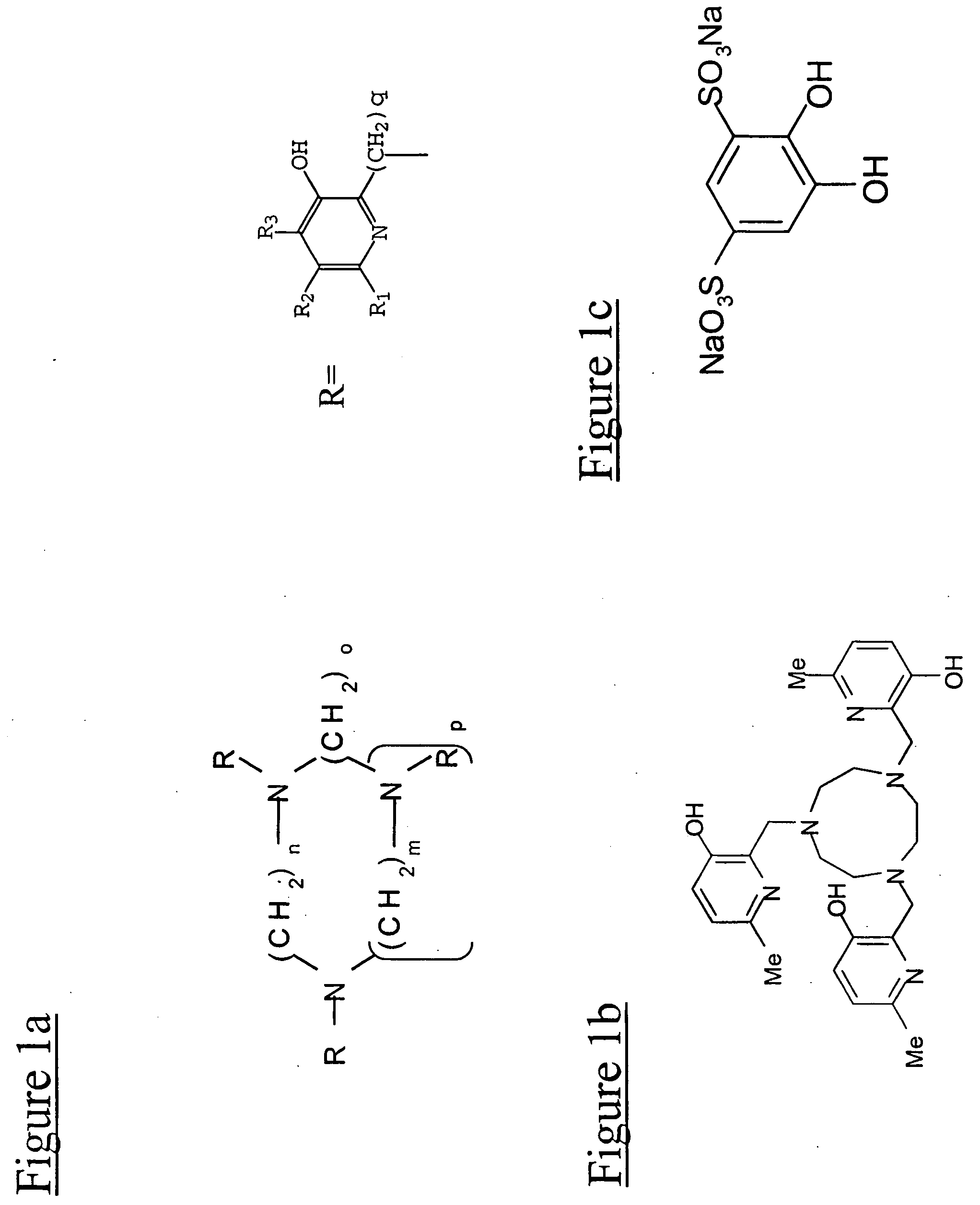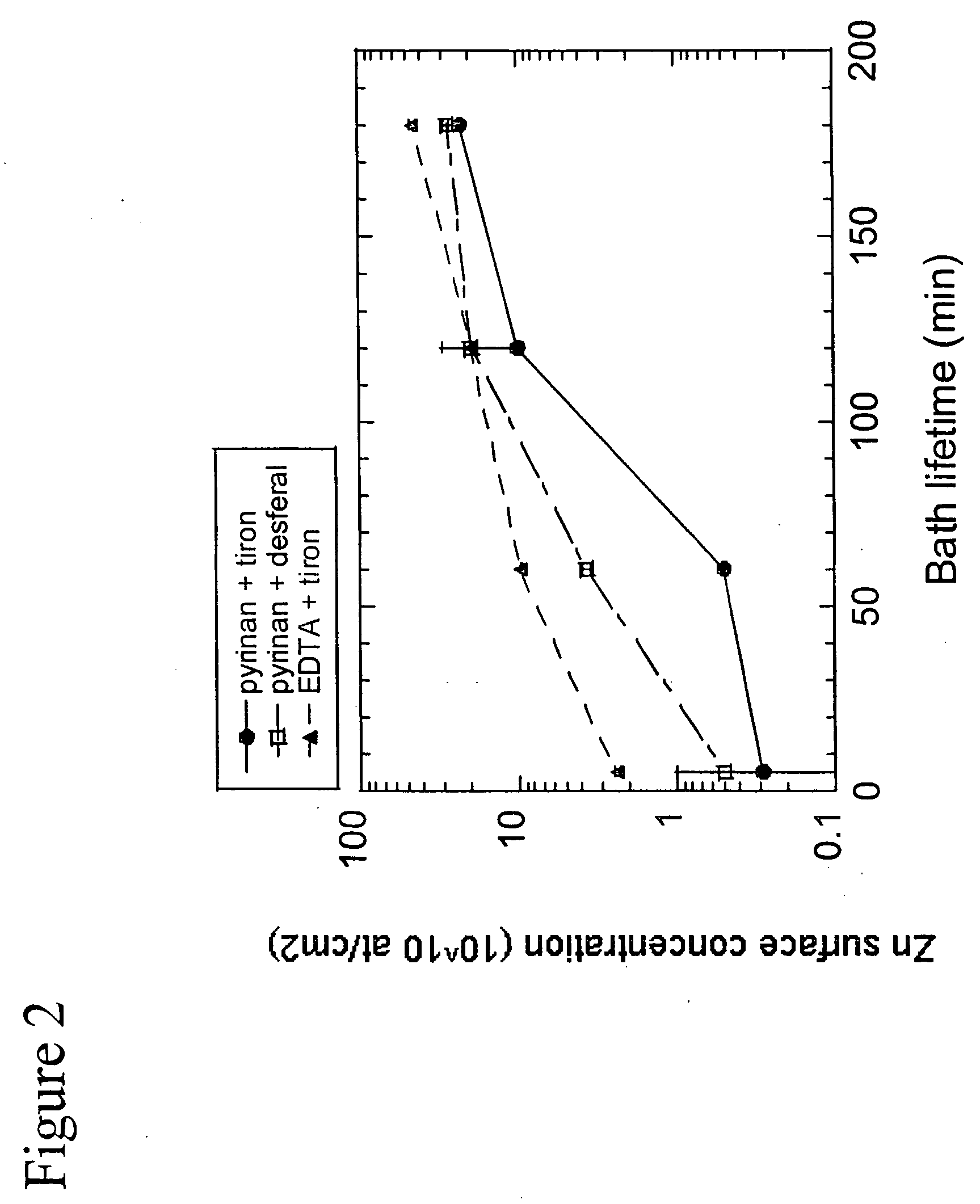Semiconductor cleaning solution
- Summary
- Abstract
- Description
- Claims
- Application Information
AI Technical Summary
Benefits of technology
Problems solved by technology
Method used
Image
Examples
example 1
Metal Outplating from APM Mixtures in Presence of Different Complexing Agents
[0094] The efficiency of complexing agents to suppress the deposition of metallic contamination onto wafer surfaces was studied. This was done through intentionally spiking controlled trace amounts of metallic contamination to cleaning solutions. For these metal deposition tests, p-type monitor wafers with a diameter of 150 mm and orientation were used. The wafers were pre-cleaned using IMEC Clean® in an automated Steag wet bench (i.e. SOM+dHF+O3-rinse rendering a perfectly clean hydrophilic surface).
[0095] The metal deposition experiments were performed in a static quartz tank with a quartz cover plate. This tank was not equipped with a megasonic transducer. APM mixtures were prepared containing 1 w-ppb of different metals of interest with / without the complexing agent added. The metals spiked to the APM bath were added from AAS-standard solutions (Merck). After a bath age of 5 minutes, three wafers were...
example 2
Removal of Metallic Contamination from Silicon Wafer Surfaces using APM Cleaning Solutions with Different Metal Complexing Agents
[0102] The final metal surface concentration after cleaning intentionally metal contaminated wafers using a 0.25 / 1 / 5 APM clean without any complexing agent at 70 C is summarized in FIG. 3.
[0103] For Ca, a rather strong effect of the cleaning time is observed: a 1 min APM removes only 90% of the Ca contamination while a 10 min. clean removes Ca to around 2×1010 at / cm2. Note that this is also the final Ca surface concentration measured on blank wafers processed. This indicates that the remaining Ca concentration is due to Ca (re)deposition presumably not during cleaning but during the final rinse step.
[0104] In absence of complexing agents, an APM clean at 70 C can easily remove Cr, Ni and Cu below 0.5×1010 at / cm2 even when 1 min. cleaning time is used. The Fe and Zn contamination levels are reduced by one order of magnitude, i.e. from ±1012 down to 1011 ...
example 3
Decomposition of Peroxide in APM Cleaning Mixtures in Presence of Trace Metal Contamination and Metal Completing Agents
[0108] The effect of the addition of a complexing agent to APM cleaning solutions on the kinetics of the decomposition reaction of H2O2 has been investigated (FIG. 7). Well-controlled amounts of metallic contamination were added to the cleaning mixture under study.
[0109] As hydrogen peroxide decomposes, an amount of oxygen gas is liberated following the overall reaction
2H2O2⇄O2+2H2O
[0110] The decay of the total peroxide concentration in the APM mixture can be monitored by measuring the time-dependent increase of the pressure due to the O2-evolution in a dedicated set-up as described by Schmidt.
[0111] Numerical integration over time yields the actual peroxide concentration in the bath. It is convenient to use peroxide concentrations normalized to its initial value [H2O2]i as [H2O2]n=[H2O2][H2O2]i
[0112] Since the decomposition reaction is mainly catalyzed by ...
PUM
 Login to View More
Login to View More Abstract
Description
Claims
Application Information
 Login to View More
Login to View More - R&D
- Intellectual Property
- Life Sciences
- Materials
- Tech Scout
- Unparalleled Data Quality
- Higher Quality Content
- 60% Fewer Hallucinations
Browse by: Latest US Patents, China's latest patents, Technical Efficacy Thesaurus, Application Domain, Technology Topic, Popular Technical Reports.
© 2025 PatSnap. All rights reserved.Legal|Privacy policy|Modern Slavery Act Transparency Statement|Sitemap|About US| Contact US: help@patsnap.com



